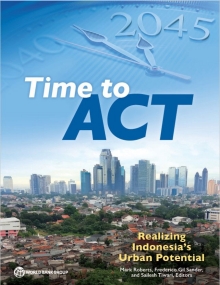A rapidly urbanizing Indonesia
- Indonesia, the world’s fourth most populous country, stands as a country transformed by urbanization.
- Today, about 151 million people – over half of Indonesians – live in cities and towns, roughly 18 times the population of London.
- By 2045, the centenary of its independence, approximately 220 million people – or more than 70% of the population – will be urban.
- As Indonesia has urbanized, so has it climbed the ladder of development and prosperity.
- Since 1950, average gross domestic product (GDP) per capita has increased almost nine-fold in real terms, and the average Indonesian today enjoys a standard of living far surpassing that of previous generations.
- In part, a more prosperous Indonesia today is due to the productivity benefits that arise from urban agglomeration and the associated transformation from an agrarian society to one more based on industry and services.
What’s holding cities back
- However, that climb has been slower and more arduous than the rapid pace of urbanization. Hence, Indonesia remains a lower middle-income country.

- Although almost everyone has benefitted in absolute terms, the relative gains from urbanization have been uneven within cities and across the country.
- The unprecedented growth of urban areas has given rise to negative congestion forces, associated with the pressure of urban populations on infrastructure, basic services, land, housing, and the environment, that are undermining the livability of cities and dampening the prosperity gains from urbanization.
- Urbanization has not fulfilled its potential to drive sustainable improvements in prosperity, inclusiveness, and livability in Indonesia.
Time to ACT to unleash the urban potential
- To ensure that Indonesia gets the most out of urbanization, policymakers need to undertake bold institutional reforms and implement decisive policies to ACT:
- Augment the coverage and quality of basic services and urban infrastructure to better manage congestion forces and address large disparities in human capital outcomes both across and within places.
- Connect urban areas of different sizes with each other, with surrounding rural areas, and with international markets – and to connect people with jobs and basic services within urban areas – to enhance inclusiveness both within and among areas.
- Target places and people that may be left behind by the urbanization process to ensure that they share in the prosperity benefits of urbanization and that urban areas are livable for everyone.
- Implementing policies to ACT involves reforming how urban areas are managed and financed with a focus on:
- Expanding options for financing infrastructure and basic services;
- Improving coordination between different levels and sectors of government and between districts that belong to a common metropolitan area;
- Building stronger capacities to plan, implement, and finance urban development.
- It will be necessary to tailor many of the policy actions required to ACT according to the type of place. For example, according to whether an urban area is a large metropolis, such as Jakarta or Surabaya, or a smaller, less connected urban area such as Bima.
Leave no one behind
- Even though such measures provide the foundations to ACT, they are unlikely to be sufficient to connect people with jobs and services in urban areas.
- Additional policies and investments will be needed to facilitate the supply of well-located affordable housing, better urban public transport, and the better management of traffic within a framework of more effective urban and spatial planning.
- Adequately connecting urban areas with each other, with surrounding rural areas, and with international markets will also require addressing key regulatory issues in transportation markets.
- Making sure that no island and no place are left behind will require Indonesia to rethink its approach to place-based policies aimed at assisting lagging regions, putting a stronger emphasis on human capital in the design of those policies.
- A paradigm shift in urban planning and design is also necessary to ensure that all groups of society – especially women and girls, the elderly, and persons with disabilities – fully benefit from all that urban areas have to offer.
Read the full report and its policy recommendations here.